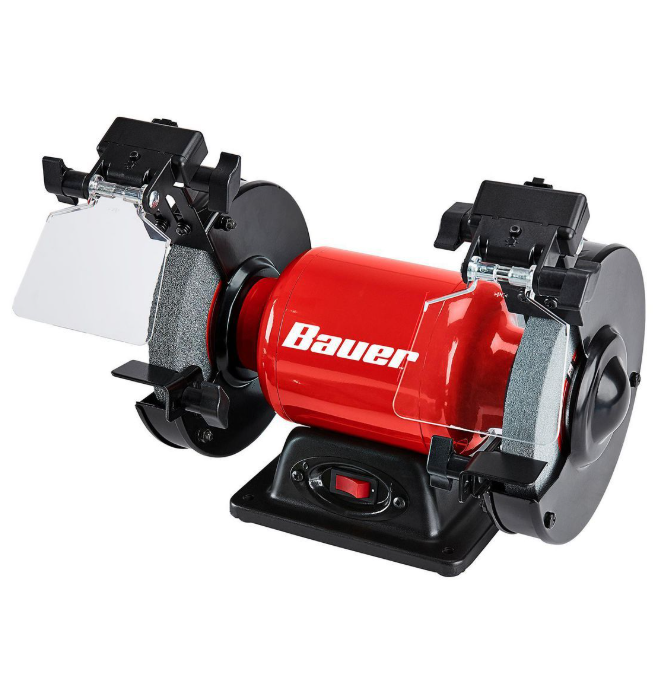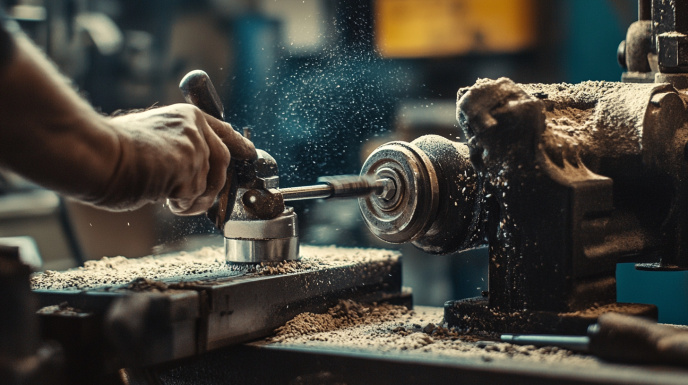
BAUER 6 in. Bench Grinder with LED Lights
- Powerful 2.1 Amp, 1/3 HP motor provides reliable operation that won’t bog down
- 3450 RPM max for high speed material removal
- Dual 6 in. aluminum-oxide grinding wheels for grinding, sharpening, deburring, polishing and cleaning
Unlocking Workshop Potential Without Breaking the Bank
There’s something deeply satisfying about the whir of a bench grinder coming to life in a workshop. That distinctive sound signals the imminent transformation of dull to sharp, rough to smooth, and problem to solution. When I first set up my home workshop, I spent weeks researching the perfect bench grinder that wouldn’t drain my wallet yet could handle everything I’d throw at it. That journey eventually led me to the Bauer bench grinder, a tool that has since become the unsung hero of my creative space.
Today, I want to share my complete experience with this workshop essential, from initial purchase considerations to daily use and everything in between. Whether you’re a seasoned craftsperson or just setting up your first workspace, understanding the full capabilities of this affordable powerhouse might just transform your approach to metalworking, sharpening, and general workshop tasks.
The Budget-Friendly Workshop Essential
Let’s address the elephant in the room right away – the price point of the Bauer bench grinder makes it one of the most accessible quality tools in its category. Currently priced at around $89.99, it sits comfortably in that sweet spot between the ultra-cheap models that fail within months and the premium options that might cost three times as much. For many home hobbyists and DIY enthusiasts, this represents the perfect balance of affordability and functionality.
Harbor Freight Tools is the exclusive retailer for Bauer tools, including this bench grinder. While you can find the grinder in their physical stores nationwide, many workshop owners prefer ordering through Harbor Freight’s online store for convenience. I’ll admit I was initially skeptical about purchasing a power tool from Harbor Freight – they’ve historically had a mixed reputation – but the Bauer line has been consistently proving itself as their serious attempt to compete with mid-range tool brands.
What surprised me most during my research was how this price point didn’t necessarily translate to significant compromises in construction or capability. The value proposition becomes even more apparent when you consider that many competing models in this price range cut corners on essential features like tool rests or adequate power.
Diving Into the Specifications
Understanding the technical specifications of any power tool is crucial for matching it to your specific needs, and the Bauer bench grinder doesn’t disappoint in this department.
At its heart pumps a 2.1 amp induction motor, delivering a no-load speed of 3,450 RPM. This might not sound impressive compared to the 3-5 amp motors on premium models, but in practice, I’ve found this power rating more than sufficient for typical home workshop applications. The induction motor design also offers advantages in terms of durability and noise reduction compared to universal motors found in some competitor models.
The standard configuration features dual 6-inch wheels – a 36-grit wheel for aggressive material removal and a finer 60-grit wheel for more precise finishing work. These wheel dimensions hit the sweet spot for most users; large enough to provide good working surface area but not so large that they require excessive power or make the unit unwieldy.
The grinder weighs approximately 16.5 pounds, making it substantial enough to remain stable during operation while still being manageable to move around when needed. Its compact footprint (approximately 12″ x 7″ x 8″) means it won’t dominate precious workspace, which proved crucial in my modestly-sized garage workshop.
One specification that particularly impressed me was the cast iron base. Despite the budget-friendly price, Bauer didn’t cut corners on this critical stability component. The solid base provides necessary heft and vibration dampening that cheaper plastic-based models simply can’t match.
From Box to Bench: First Impressions and Setup
When my Bauer bench grinder arrived, the packaging was sufficient though not exceptional – standard cardboard box with foam inserts protecting the unit. What did impress me was finding that the grinder came with both grinding wheels pre-installed, something not all manufacturers include at this price point.
The unit ships with two adjustable tool rests, two spark deflectors, and basic mounting hardware. Assembly required minimal effort – attaching the spark guards and tool rests took less than 15 minutes with just a screwdriver. The manual provides clear instructions for this process, though experienced users might not even need to reference it.
One minor disappointment was the absence of eye shields, which many competitors include. I immediately purchased these separately, as eye protection is non-negotiable when using any grinding equipment. The grinder features standard mounting points for aftermarket shields, so adding them wasn’t complicated.
The rubber feet provided excellent stability on my workbench, though for permanent installation, the base includes pre-drilled mounting holes. I eventually opted to bolt mine down for maximum stability during more intensive grinding sessions.
One initial observation worth noting: like many new grinders, there was a distinct odor during the first few uses as manufacturing oils and other residues burned off. I ran the grinder for about 20 minutes in a well-ventilated space before actual use, which largely eliminated this issue.
Daily Use: Versatility in the Workshop
Where the Bauer truly shines is in its day-to-day versatility. I’ve found myself using it for everything from sharpening chisels and restoring old plane blades to deburring metal cuts and even reshaping small metal components for custom projects.
For tool sharpening, which represents about 60% of my usage, the Bauer performs admirably. The 3,450 RPM speed is ideal for general sharpening tasks, and I’ve successfully restored everything from garden tools to woodworking equipment. The key is proper technique and patience rather than raw power – something this grinder accommodates well with its consistent performance.
The adjustable tool rests prove invaluable for maintaining precise angles during sharpening operations. While not as refined as premium models with micro-adjustments, they maintain position well once tightened and provide stable support. I did find that occasionally checking the tightness of the tool rest screws became part of my routine, as vibration can gradually loosen them.
One concern many potential buyers express relates to heat generation during grinding operations. Excessive heat can ruin the temper of high-carbon steel tools, rendering them useless. In my experience, the Bauer generates comparable heat to other grinders in its class – which means proper technique remains essential. I maintain a small container of water nearby for frequent cooling and avoid applying excessive pressure.
Beyond sharpening, the grinder handles light metalworking tasks with ease. I’ve shaped small brackets, removed rust from salvaged hardware, and prepared surfaces for welding without any issues. For these operations, the included 36-grit wheel proves aggressive enough for efficient material removal while still maintaining reasonable control.
Flexibility with Wheel Options
The standard configuration of coarse and medium grinding wheels works well for general purposes, but one of the Bauer’s strengths is its compatibility with a wide range of 6-inch wheel types.
I’ve successfully used wire brush wheels for cleaning operations, felt polishing wheels for final finishing, and even specialized CBN (Cubic Boron Nitride) wheels for high-speed steel tools. The standard 1/2-inch arbor size means finding compatible wheels is never a challenge.
Replacing wheels is straightforward, requiring only basic tools. The process involves removing the wheel cover, loosening the arbor nut (remember that the right side has standard right-hand threads while the left side has reverse threading), and swapping wheels. I recommend wearing gloves during this process and conducting the “ring test” on new wheels to check for cracks before installation.
Harbor Freight sells replacement wheels directly, but I’ve found better selection and sometimes better pricing through dedicated abrasives suppliers online. This flexibility to use third-party wheels significantly expands the grinder’s utility without being locked into proprietary accessories.
For my woodworking projects, I occasionally swap in a silicon carbide wheel specifically designed for non-ferrous materials. This configuration works beautifully for touching up carbide router bits and other woodworking tools that would quickly load up standard aluminum oxide wheels.
The Light Issue and Workspace Considerations
One notable absence from the Bauer’s feature set is built-in work lights, which more expensive models often include. After a few frustrating experiences trying to see small details during precision sharpening, I addressed this by mounting an adjustable LED task light on my workbench near the grinder.
This modification highlighted an important consideration for any bench grinder setup: creating a proper work station around the tool. I’ve since added a custom shelf above the grinder to hold various jigs, gauges, and frequently used accessories. This organization transforms the grinder from an occasional-use tool to an efficient workstation centerpiece.
Dust collection represents another workspace consideration. The Bauer doesn’t include dedicated dust ports, which is common at this price point. My solution involved positioning the grinder near my shop vacuum with a flexible capture hood that can be positioned as needed. For lighter use, simply positioning the grinder to direct debris away from other tools and materials may be sufficient.
For noise management, the Bauer operates at approximately 70-75 decibels under load – louder than conversation but quieter than many shop tools like table saws. While hearing protection is always recommended, I’ve found the noise level manageable for short durations when necessary.
Durability and Long-Term Performance
I’ve now used my Bauer bench grinder for over two years, averaging several hours of operation weekly, and can speak to its durability with some authority. The cast iron construction and quality bearings have maintained alignment without developing the wobble that often plagues budget grinders.
The motor has shown no signs of overheating even during extended sessions, though I’m careful to give it cooling breaks during particularly demanding work. This thermal management is crucial for long-term motor health, and the Bauer seems well-designed in this regard with adequate ventilation.
Switch reliability has been excellent – the large paddle-style power switch remains positive in action without developing the sponginess that often affects cheaper tools over time. This might seem like a minor point, but a reliable switch is crucial for safety and operational confidence.
The only maintenance I’ve needed to perform beyond wheel replacements was occasional cleaning of the tool rests and a single application of light machine oil to the motor bearings after the first year. The simplicity of the design means fewer components that can potentially fail.
Safety Considerations
No discussion of grinding equipment would be complete without addressing safety considerations. The Bauer includes basic spark deflectors, but as mentioned earlier, lacks eye shields. I consider proper safety equipment non-negotiable, including:
- Safety glasses or preferably a full face shield
- Hearing protection
- Breathing protection when grinding materials that produce hazardous dust
- Close-fitting clothing that won’t catch in rotating equipment
The grinder’s power switch is conveniently located for emergency shutoff, and the unit comes to a stop relatively quickly after power is cut – an important safety characteristic. I’ve added an additional safety feature by connecting mine to a switch-operated outlet that allows shutdown without reaching across the work area.
The inclusion of tool rests is not just about work precision but safety as well. They provide crucial support to prevent workpieces from being pulled downward between the wheel and rest – a common cause of grinding accidents. The Bauer’s tool rests adjust easily and lock securely, which I consider essential safety features.
Comparing to Other Brands
Having previously owned grinders from both budget and premium categories, I can offer some comparative context for the Bauer’s performance.
Compared to entry-level models from brands like WEN or Craftsman, the Bauer offers noticeably better build quality, particularly in the robustness of the motor and the stability of the base. The tool rests are also markedly superior to those found on the absolute cheapest options.
Against premium brands like DeWalt or Metabo, the differences become more apparent in refinement rather than basic functionality. The premium models typically offer better bearing quality, more precise adjustment mechanisms, and additional features like integrated lighting and tool storage. However, these improvements come at a 2-3x price increase that may be difficult to justify for casual users.
Perhaps the most direct competition comes from models like the Ryobi BGH616 or the Porter-Cable PCB575BG, both positioned similarly in the market. In comparison testing, the Bauer held its own admirably, with comparable power delivery and slightly better vibration control than these alternatives.
For hobbyists and DIY enthusiasts working within budget constraints, the Bauer represents an exceptionally strong value proposition. Professional users with continuous heavy-duty applications might still benefit from investing in premium options, but even in many commercial settings, the Bauer proves surprisingly capable.
Practical Applications in the Workshop
Over time, I’ve discovered numerous applications for the Bauer beyond the obvious sharpening tasks. Here are some of the most valuable uses I’ve found:
For woodworkers, beyond tool sharpening, the grinder excels at modifying hardware. I’ve adjusted hinge sizes, customized fasteners, and even shaped small specialty tools from stock metal. The consistent speed makes these operations predictable and controllable.
Metal sculptors and artists in my community have adopted the Bauer for detail work and material preparation. Its compact size allows for placement in limited studio spaces, while providing sufficient power for artistic metal shaping. Several have mentioned the reasonable price point as allowing them to dedicate different wheels to different materials without maintaining multiple complete grinder setups.
In restoration work, the grinder proves invaluable for cleaning and refurbishing vintage tools and hardware. I’ve successfully restored several hand planes and chisels from flea market finds to daily users, with the Bauer handling the initial cleanup and reshaping before final honing with stones.
For general household maintenance, I’ve used it for everything from sharpening lawnmower blades to reshaping screwdrivers that have become damaged. This versatility makes it one of the few power tools that crosses the boundary between workshop projects and practical home maintenance.
Warranty and Support
The Bauer bench grinder comes with a 90-day warranty, which falls short of the 1-3 year coverage offered by some competitors. This limited warranty period might concern some potential buyers, but in practice, most manufacturing defects become apparent within the first few uses.
Harbor Freight’s customer service has improved substantially in recent years, and they generally honor warranty claims without excessive complications. Having visited their stores for other warranty matters, I’ve found the process straightforward when accompanied by proof of purchase.
For out-of-warranty support, Harbor Freight now stocks a reasonable selection of replacement parts for Bauer tools, though specialized components may still require special ordering. The modular design of the grinder means that many common failure points like switches and bearings can be replaced with standard parts available from multiple sources.
Online support communities have also emerged around Harbor Freight tools, with dedicated forums providing troubleshooting assistance and modification advice that extends beyond the manufacturer’s documentation. These resources prove invaluable for maximizing the tool’s lifespan and performance.
The Final Verdict
After exhaustive use across countless projects, I’ve developed a clear perspective on the Bauer bench grinder’s place in the workshop ecosystem.
For beginning woodworkers, DIY enthusiasts, and hobbyists with occasional metalworking needs, the Bauer represents an exceptional value. Its combination of adequate power, reasonable build quality, and accessible price point makes it a logical entry point into precision grinding operations.
For professional settings with continuous heavy production demands, the limitations become more apparent. The motor, while adequate for typical operations, may struggle with continuous heavy grinding sessions that premium models handle with ease.
Perhaps the most compelling argument for the Bauer is its role as a “gateway tool” that allows users to develop skills without significant financial investment. Many users (myself included) find that mastering proper grinding technique with an accessible tool like the Bauer actually reduces the need for premium equipment, as operator skill often compensates for minor equipment limitations.
In my own workshop, the Bauer continues to earn its place through consistent performance and versatility. It represents that perfect middle ground where capability meets accessibility – a combination that’s increasingly rare in today’s specialized tool market.
Whether you’re resharpening garden tools, restoring vintage hand planes, or creating custom metal components, the Bauer bench grinder delivers reliable performance without breaking the bank. And in today’s workshop environment, that practical balance of quality and value deserves recognition and appreciation.
Final Thoughts and Recommendations
If you’re considering adding a bench grinder to your workshop arsenal, the Bauer warrants serious consideration, particularly if you’re working within budget constraints or have occasional rather than production-level needs.
For optimal results, I recommend several accessories to complement the basic unit:
- A diamond wheel dresser for maintaining wheel shape and cutting efficiency
- A set of quality aftermarket eye shields
- A dedicated grinding jig for consistent bevel angles when sharpening
- A good task light positioned to eliminate shadows on the work area
With these modest additions, the capabilities of this affordable grinder expand dramatically, approaching those of units costing significantly more.
The workshop journey is always about finding the right tools for your specific needs rather than simply acquiring the most expensive options available. In that context, the Bauer bench grinder represents one of those rare tools that delivers capability beyond its price point – making it not just a purchase, but a genuine workshop investment.

